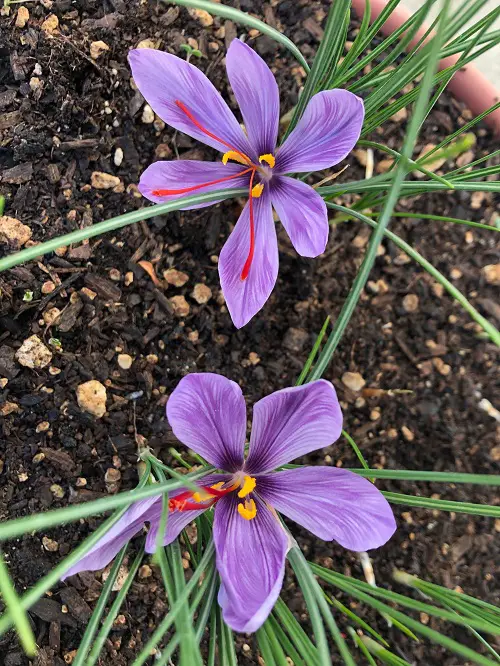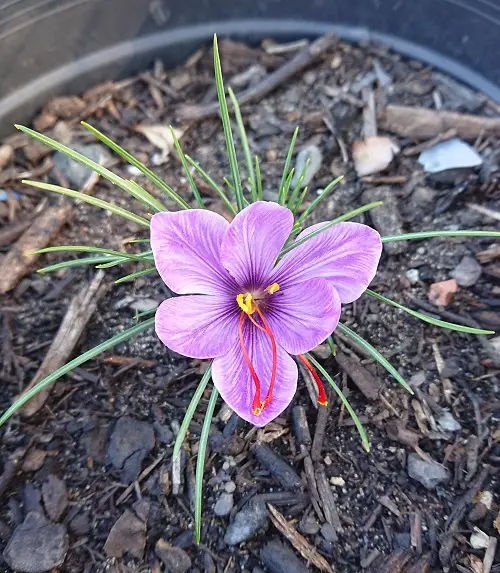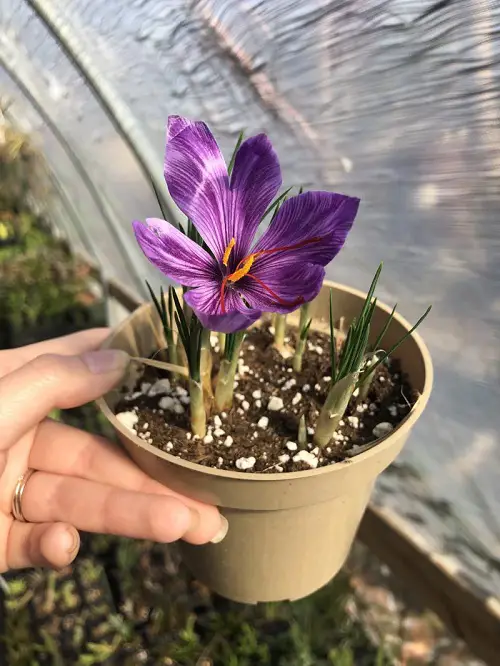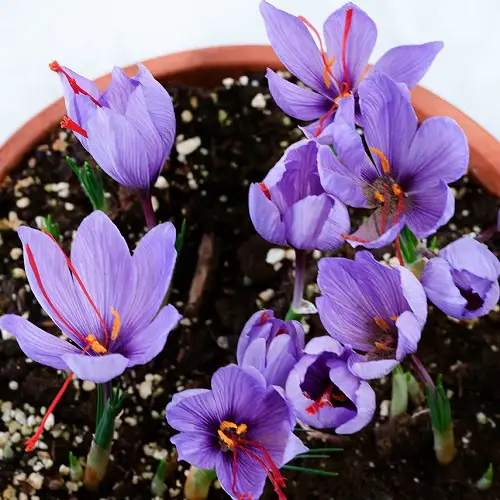The most expensive spice in the world, growing saffron in pots makes a lot of sense! Here are all the details to do it right!
Ranging from $500 to $5,000 per kilogram, Saffron, or the Red Gold as it is commonly referred to, takes a total of about 150,000 flowers to produce just one kg, and this is why it’s difficult to get pure Saffron; it is often adulterated! Now you know why it would be a great idea to grow its plant at home!
Saffron Types and General Information
Saffron is known for its incredible sweet scent and bitter taste, with subtle metallic notes that are unique in flavor and fragrance. It is loaded with antioxidants and has multiple health benefits, including weight loss. Saffron threads are used for seasoning, dye, aroma, and medicine.
USDA Zones: 6-9
Difficulty: Moderate to Hard
Botanical Name: Crocus sativus
Other Names: Saffron Crocus, Winter Crocus, Faran (Thailand), Kesar (India), Fan Hong Hua (China), Zafferano (Italy), Safran (France, Germany).
Types of Saffron and Best Varieties to Grow
There are five main types of Saffron popular in the name of their growing regions:
1. Iranian Saffron, which is of the highest quality and potency and is most common.
2. Kashmiri Saffron, from India, it is known for its intense aroma and color and uses in special recipes.
3. Spanish Saffron, which is considered best for culinary uses and flavor.
4. Greek Saffron, from Greece, which is also known for its fragrance but less exported.
5. Morrocon Saffron, not as superior as the above four.
You may find these saffron types recognized by their growing location for buying and propagation instead of the names of varieties.
However, if you’re still looking for varieties, go for Super Negin, Sargol, Negin, and Poshal, which are all Iranian varieties.
Regarding Spanish ones, look for the corms of Coupe, La Mancha, and Rio for growing.
Where Does Saffron Grow (Best USDA Zones)
Saffron grows best in USDA Zones 6 to 8, but if you’re growing in much colder or warmer zones, pick these varieties, read below.
If you’re about to grow your own saffron in USDA Zone 9 or a similar warmer region, choose Iranian or Moroccan varieties.
For USDA Zones 4 to 6, which are colder, grow Spanish or Kashmir saffron corms, as these are more cold-tolerant.
Propagating Saffron

Growing saffron via seeds is a complicated process, but growing it via bulbs or corms is much easier and faster. The best time to plant saffron is late summer or early fall, at least 3 months before the first expected frost date in your region.
Buy a big and mature bulb that will lead to production in the first year itself in just 7-8 weeks after planting. Don’t get fresh or small corms, as they will only yield saffron for 2-3 years.
Once you have the corms, plant them 2-4 inches deep in a container, and don’t pack them up closely. Space them 3-5 inches apart–make sure the pointed end faces up (getting slightly exposed, a few mm, to the air) and the flat side is down.
The potting soil should have excellent drainage and also add a good layer of compost. Keep it evenly moist and locate the pot in full sunlight, where it receives 8 hours of sun exposure or at least 5-6. In several weeks, if you do all this, your bulbs will start to flower soon!
Do note that these plants go dormant in summer and require less watering during this period.
Choosing the Right Container for Saffron
It is important that you don’t select a really deep pot. Select a container that is 8 inches deep and wide similarly or as much as possible. You can also choose rectangular window boxes that you may use for growing green onions.
Requirements for Growing Saffron
Sunlight
For the best saffron strands, make sure the plant gets at least 5-6 hours of direct sunlight, but the more, the better.
If you live in a cooler zone, find a south or west-facing spot for maximum sunlight exposure.
Soil
While growing saffron in pots, it is essential that you save the bulbs from rot, and using 100% garden soil can lead to too much water retention, which can cause just that.
Ideal soil is one of the challenges when it comes to growing saffron indoors or in the home garden. The soil should be loamy, somewhat like you use for succulents, but contrastingly richer in organic matter like compost.
To make the best saffron soil mix, combine 2 parts of loam, 1 part of organic matter like well-rotted manure or compost (you can also mix half part humus in this one part of organic matter), and 1 part sharp coarse sand or perlite—this will give it all the aeration and nutrients it needs for the best growth!
Watering
Remember, the key to making the plant thrive is understanding its watering needs according to the different saffron growing stages.
After planting, water only when the topsoil goes a bit dry—about an inch; you can use a moisture meter to determine the exact need to water again.
Once the plant starts growing actively and you see the signs of bloom, it will require slightly more water. You can achieve this by moistening the growing medium when just the surface of the topsoil goes dry, typically half an inch to one inch dry.
In summer, when the plant reaches its dormancy, reduce watering!
Remember–overwatering may cause the bulbs to rot and eventually kill the plant, so avoid it at all cost, when growing saffron in a container.
Temperature
You will get the best saffron in a climate with moderately hot, dry summers and cool, wet winters, which you get in the Mediterranean climate.
The ideal temperature range during the crocus growing season is between 60°F (15°C) to 80°F (27°C). In winter, they can tolerate temperatures as low as 35°F (1.7°C).
According to one study published in Science Direct, the best temperature for flower appearance was between 23 and 27°C (73 to 80°F), with 23°C being the best.
Saffron Plant Care
Fertilizer
You don’t need to fertilize a lot after the addition of organic matter. However, to promote flowering, you can use a weak-strength low-nitrogen blend, such as a 5-10-10, which will also help in root development.
Apply it 4-5 weeks after planting the corms in late summer or early fall, which is in late July or August, when you see growth and developing leaves.
Dilute it to half of its recommended strength, and use it again after 4-5 weeks. Stop fertilization in warmer months.
Pests and Diseases
The only thing you need to be vigilant about while growing saffron crocus in pots is root rot—that’s it! The best way to battle it is to be careful with watering, and we have explained how to do this in the watering section.
Watch for mice and voles and chipmunks – they love to eat the bulbs!
Harvesting Saffron

The key to getting the BEST quality saffron is to harvest it as soon as the flowers open; the flowering period can take anywhere from 8-10 weeks to arrive.
- The best time to harvest the plant is in the morning – the flowers are usually open fully this time, and the stigmas are the most vibrant and aromatic!
- Look for the red stigmas and gently pick them up using tweezers – don’t use your hands as you might break them from the middle. Each flower has three main stigmas.
- The moment you pick the stigmas, keep them immediately for drying. Place them on a dry paper towel and keep them in a well-ventilated place away from direct sunlight. Avoid keeping them in a dehydrator or oven, as it will kill the flavor. Proper drying guarantees the best taste and aroma!
- Once they are dry, keep them in an airtight container away from direct sunlight.
Don’t expect homegrown plants to give you an enormous yield! Remember, you will need approximately 150 flowers to get 1 (Yes, just one) gram of dried saffron!






